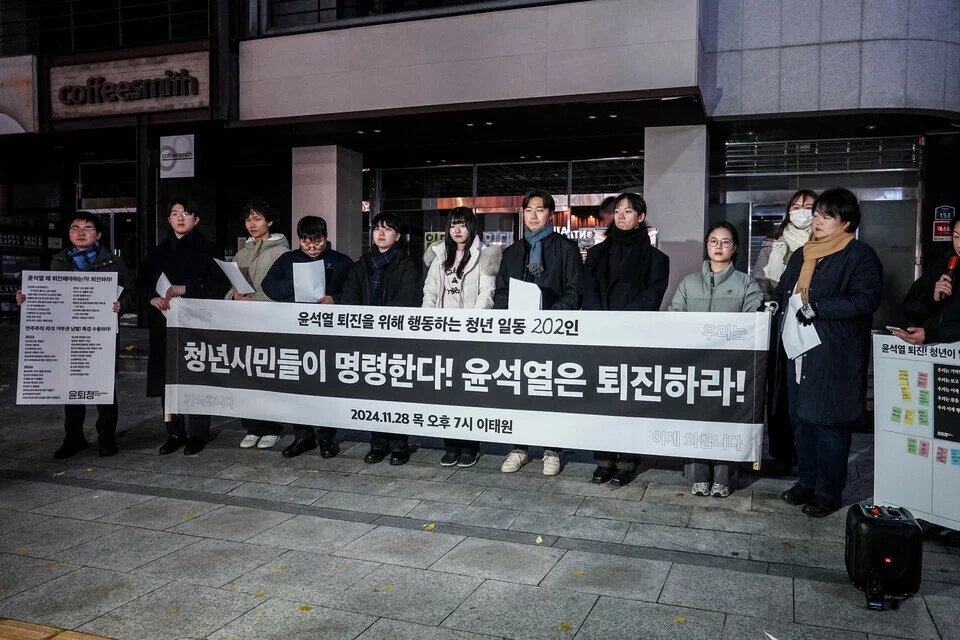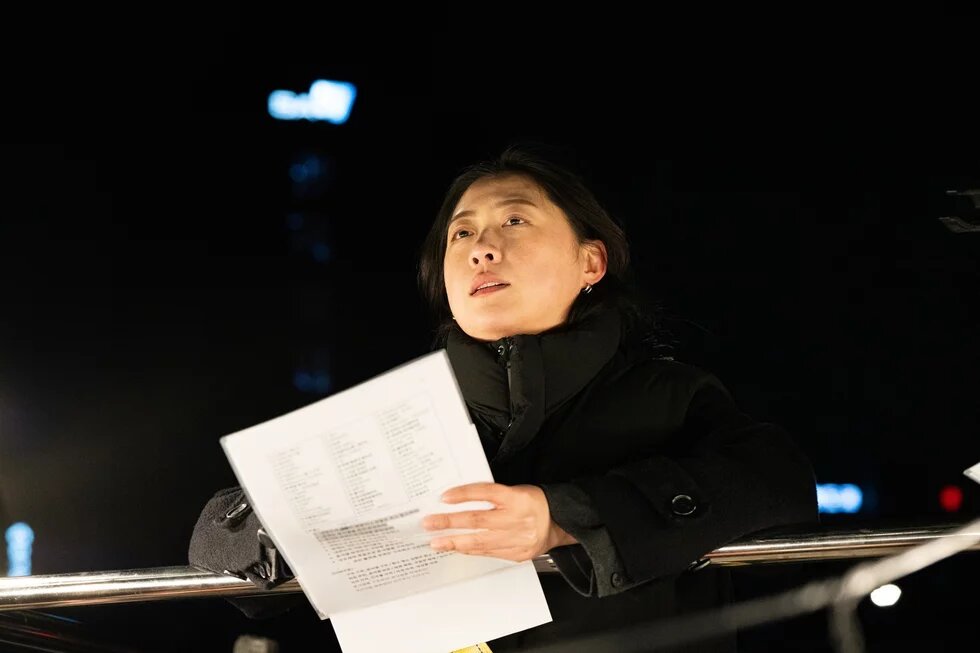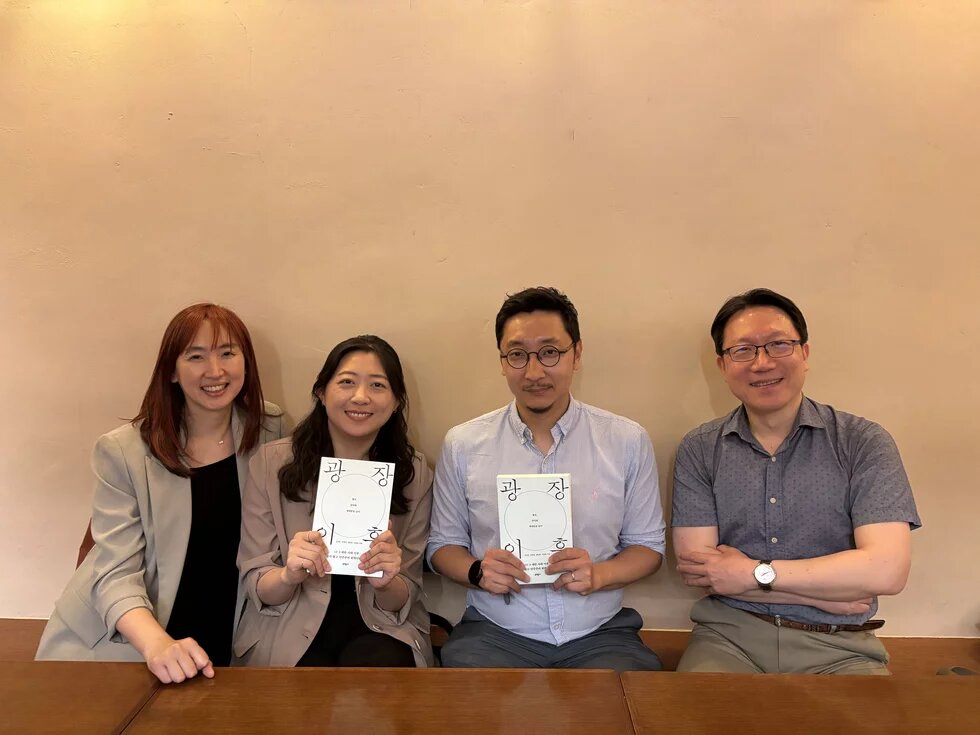
On December 3, 2024, President Yoon Suk-yeol’s declaration of martial law dealt a profound shock to South Korean democracy. Yet in that moment of crisis, the square came alive once again—and at its center stood the youth. The lights, the flags, and the questions that followed have now been captured in a book. After the Square tells the story of young people who organized themselves to call for President Yoon’s resignation, created spaces for public dialogue, and put democratic values into action. We spoke with one of the book’s co-authors, Jaejeong Lee.
Ⓒ Provided by YoonToiCheong (Youth for Yoon’s Resignation)
Source: Sisa Journal (www.sisajournal.com)
1. Could you briefly introduce the book 'After the Square'?
After the Square examines Korean democracy following the December 3rd martial law crisis that divided society over President Yoon Suk-yeol's impeachment. The book analyzes complex political dynamics involving class, gender, generation, ideology, and more to explore Korea's potential future directions.
Four authors contribute distinctive yet interconnected perspectives: Professor Jinwook Shin (Department of Sociology, Chung-Ang University) studies backsliding democracy and far-right populist movements in Korea. An early-career researcher specializing in precarious labor Jaejeong Lee presents findings and reflection on survey completed with young protest participants. Professor Seunghoon Yang (Sociology, Kyungnam University) examines discourse around the alleged "far-right shift" among young men in their 20s and 30s, and proposes alternative interpretations. Professor Seungyoon Lee (Department of Social Welfare, Chung-Ang University) provides research on youth insecurity and class perceptions.
The book transcends narratives of polarization and generational conflict to reveal civic life's complexity, questioning how to restore and renew democracy.
2. Now that the book is out in the world, what thoughts or emotions come to mind when you look back on the “square”?
The square's glittering lights and rhythmic flags created collective brilliance during the martial law crisis. Each light and symbol differed, yet unified to show that ordinary Korean citizens have the strength to overcome the crisis.
While elites triggered the crisis, the marginalized stood firm and fought for the societal stability. This motivates my work collecting and amplifying their voices through documenting the stories of those who participated in the protests and organizing youth-focused and youth-centered forums that evaluate both the square and presidential election from younger generation’s perspectives rather than viewpoints of older generations.
The square's legacy should reflect collective dedication, diverse narratives, and shared demands rather than individual figures.
3. What kind of organization is “Youth Demanding Yoon Suk-yeol’s Resignation (YoonToiCheong),” the group that connects you with the square?
My career spans around civic organizations, the National Assembly, and political parties. Prior to martial law declaration, government corruption under Yoon Suk-yeol's administration was emerging alongside irresponsible responses to the Itaewon tragedy and Corporal Chae incident, intensifying already pent-up public anger. On 23 November, I proposed a "Youth Civic Declaration on the National Crisis" with like-minded colleagues, initiating the Youth Demanding Yoon's Resignation (YoonToiCheong) movement.
Initially conceived as a single declaration, the movement evolved after President Yoon's martial law announcement threatened democracy. Beginning 4 December, we established a working group with assigned roles and responsibilities, and systematically organized YoonToiCheong.
Current activities include collecting and archiving youth voices from the square, participating in documentation exhibitions, and organizing forums where young participants reflect on the square and recent presidential election from their perspective. Priority lies in accurately archiving citizen stories from the square to prevent distortion and providing momentum for future activities. The organization continues developing strategies to sustain public discourse and maintain the community of practice that formed during the protests at the square.
4. As a representative of various youth organizations, what has been the most challenging moment for you?
Korean youth face multiple pressures including academic performance, employment, marriage expectations, and family-oriented responsibilities. Despite demanding schedules, young people joined YoonToiCheong to overcome the current crisis, contributing time and resources. For that, the majority experienced a significant exhaustion due to the delays in processing and proceeding.
The experience tells us that self-initiated action is crucial. Individuals must identify problems, develop solutions, and implement responses rather than relying on external intervention.
The activity of YoonToiCheong I take most pride in is having independently documented authentic and powerful voices of youth through surveys and focus group interviews. This self-initiated documentation preserved otherwise dispersed and fragmented perspectives, creating valuable resources for identifying Korean societal issues and enabling strategic thinking for a way forward.
5. Now that the new government is in power, to what extent do you think the voices from the square are being reflected in actual politics and policy?
The current government identifies itself as a "people's sovereignty government." Increased citizen engagement through regional town halls and active media communication demonstrate significant democratic restoration and advancement.
The new government brands itself as a 'people's sovereignty government.' Given the administration's increased citizen engagement through regional town hall meetings and active media communication, I believe democracy has been restored and advanced to a certain extent.
However, there is significant room for improvement in agenda setting and policy implementation. The protests in the square demanded proactive anti-discrimination measures and solutions for economic inequality, yet there has been no progress on enacting a comprehensive Anti-Discrimination Act. Discussions on diverse family forms remain absent. The government has not provided clear solutions for job market instability, inadequate social security coverage, and rising youth unemployment, to name a few.
Given the administration's early stage, I do hope effective policies and comprehensive solutions would emerge during the remaining term.
6. Many young people participated in the movement demanding Yoon Suk-yeol’s resignation as their first-ever protest. Since then, various civil society organizations have been trying to maintain connections with them. What efforts do you think civil society should make going forward to ensure that this participation does not remain a one-time event?
I see two key directions we should consider.
First, we need to introduce young people who have developed strong democratic citizenship to civil society activism as a viable career path. This means providing education about civil society organizations and connecting them with hands-on experiences. I've heard inspiring stories of citizens from the square who joined civil society groups, labor unions, or started full-time activist work. Given today's employment challenges, we need to raise awareness that positions in civil society organizations are legitimate career options. These organizations must also improve activists' working conditions and career prospects.
Second, we need to diversify how citizens can contribute to social change beyond full-time activism. Through conversations with activists from the US, Europe, and Latin America, I've learned that many organizations rely more on part-time volunteers than full-time staff. We need more opportunities for people to engage in community activities after work hours. As work becomes more diverse, it's crucial to develop flexible ways for people to balance social contribution with their careers and research.
For example, during the emergency martial law period, YoonToiCheong operated with a part-time structure where designers, researchers, and activists collaborated on research and programs. I experienced real joy inviting friends from the square to help host events and do research together.
7. In After the Square, I deeply resonated with the perspective that the square is not just a space for protests but a “living public sphere” where citizens actively engage in practice and dialogue. Do you think that the solidarity and connections formed this way can lead to sustained democratic practices even outside formal institutions?
I believe it's important to create mechanisms that allow citizens' opinions to be reflected in government policies, while also establishing everyday public forums in local communities where citizens can comfortably participate.
Korea has governance structures like the "Youth Policy Coordination Committee" that allow young people to participate in policy discussions. However, young people aren't yet empowered to lead public discourse or given meaningful authority. In Europe, each EU member country operates national youth councils that run the European Youth Forum alongside non-governmental youth organizations. The EU officially recognizes this forum as a partner and legally mandates formal consultative bodies for youth-related policies.
As social agendas like digital transformation, climate crisis, and demographic changes arise during this transitional period, the youth generation bears the greatest impact. It's crucial to empower young people as stakeholders with both responsibilities and authority to actively participate in policy-making and lead change.
Beyond formal settings, citizens should be able to naturally meet and sustain everyday public forums. Many youths who joined recent protests for the first time have developed interest in new social issues. Some lack people to discuss politics or social matters in their daily lives. We need more spaces where people can gather based on shared interests within local communities and engage in dialogue.
8. During the process of writing the book, were there any perspectives or passages from the other authors that particularly impressed you? If so, please share them.
Professor Shin Jin-wook's approach really stood out to me. Rather than viewing the so-called 'far-right' as homogeneous, he classified it into layers based on extremity levels and considered different responses for each. I believe designing practical strategies based on this nuanced understanding will be crucial for Korean society. He posed valuable questions that my colleagues and I need to ponder.
Professor Yang Seung-hoon's perspective on men in 20s and 30s was particularly striking. He cautioned against simply labeling them as conservative, instead seeing them as fluid swing voters whose stance reflects pent-up anger toward progressive forces. While I do not fully agree with all of his points, reading it made me critically reflect on the absence of meaningful youth political representation in Korea and sparked my imagination about creating new political spaces.
Professor Lee Seung-yoon's section presented interesting cases on political participation among precarious workers. There is diversification of forms of labor in Korea—platform workers, special types of employment, and K-culture workers carrying out much fragmented labor. Many unemployed youth are simply categorized as 'just resting.' While I find such phenomenon depressing, I was introduced to case study where the expansion of precarious labor worldwide has fueled new social movements. It gave me a hope about what forms of activism might be possible in Korea's context.
9. What should the next square look like, and what role do you think young people should play in it?
What set this recent public square apart wasn’t just the shimmering cheering sticks or creative flags, but the “Equality Guidelines.” These were rules we created together to affirm everyone’s equal right to participate. Before each gathering, we read them aloud—a shared pledge by organizers and participants to make the space safe and inclusive for all. Of course, there were incidents of violation, but the effort itself was meaningful. One politician who violated the guidelines faced public criticism and even issued an apology. That, to me, signals a cultural shift. I believe this will become the new norm. It’s hard to imagine moving backward from here—if anything, we will be moving forward.
The activists and citizens who shaped the 2024–2025 assemblies now carry hands-on experience they will continue applying in their lives. And I believe young people, attuned to the spirit of the times, will be at the forefront—setting new standards and leading cultural change.
See detailed information about the book After the Square



